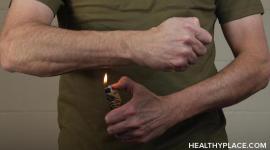Warning Signs of Self-Harm

Self-injury is defined as any intentional injury to one's own body. It can include cutting, burning, and other forms of self-harm, self-mutilation. Here are the signs of self-injury.
People who self-harm become very adept at hiding scars or explaining them away. Look for signs such as a preference for wearing concealing clothing at all times (e.g. long sleeves in hot weather), an avoidance of situations where more revealing clothing might be expected (e.g. unexplained refusal to go to a party), or unusually frequent complaints of accidental injury (e.g. a cat owner who frequently has scratches on their arms).
Types of Self-Harm
The most common forms are cutting the arms, hands, and legs, and less commonly the face, abdomen, breasts and even genitals. Some people burn or scald themselves, others inflict blows on their bodies, or bang themselves against something.
Other forms of self-harm include scratching, picking, biting, scraping and occasionally inserting sharp objects under the skin or into body orifices, and swallowing sharp objects or harmful substances ("Why Do Self-Injurers Engage in Self-Harm?").
Common forms of self-injury that rarely reach medical attention include people pulling out their own hair and eyelashes, and scrubbing themselves so hard they break the skin (sometimes using cleaners such as bleach).
Additional forms of self-harm may include:
- carving
- branding
- marking
- biting
- headbanging
- bruising
- hitting
- tattooing
- excessive body piercing
APA Reference
Staff, H.
(2008, December 4). Warning Signs of Self-Harm, HealthyPlace. Retrieved
on 2024, November 20 from https://www.healthyplace.com/abuse/self-injury/warning-signs-self-harm-self-injury


